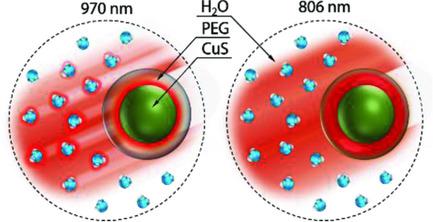Our official English website, www.x-mol.net, welcomes your
feedback! (Note: you will need to create a separate account there.)
Highly Efficient Copper Sulfide‐Based Near‐Infrared Photothermal Agents: Exploring the Limits of Macroscopic Heat Conversion
Small ( IF 13.0 ) Pub Date : 2018-10-17 , DOI: 10.1002/smll.201803282 Riccardo Marin 1, 2 , Artiom Skripka 2 , Lucas V. Besteiro 2, 3 , Antonio Benayas 2, 4 , Zhiming Wang 3 , Alexander O. Govorov 5 , Patrizia Canton 1 , Fiorenzo Vetrone 2, 6
Small ( IF 13.0 ) Pub Date : 2018-10-17 , DOI: 10.1002/smll.201803282 Riccardo Marin 1, 2 , Artiom Skripka 2 , Lucas V. Besteiro 2, 3 , Antonio Benayas 2, 4 , Zhiming Wang 3 , Alexander O. Govorov 5 , Patrizia Canton 1 , Fiorenzo Vetrone 2, 6
Affiliation

|
Among the foreseeable therapeutic approaches at the cellular level, nanoplatform‐driven photothermal therapy is a thriving tool for the selective eradication of malignant tissues with minimal side effects to healthy ones. Hence, chemically versatile, near‐infrared absorbing plasmonic nanoparticles are distinctly appealing and most sought after as efficient photothermal agents. In this work, a straightforward method to synthesize monodisperse PEGylated copper sulfide nanoparticles of pure covellite (CuS) phase, featuring strong localized surface plasmonic resonance absorption in the near‐infrared and flexible surface chemistry, imparted by monomethyl ether polyethylene glycol molecules, is developed and optimized. These nanoparticles show a remarkable photothermal heat conversion efficiency (HCE) of 71.4%, which is among the highest for CuS systems and rivals that of plasmonic noble metal nanostructures. Moreover, through critical evaluation and mathematical modeling of the material's properties and measurement methodology, it is assessed that the calculated HCE values drastically depend on experimental conditions such as wavelength‐dependent solvent absorption properties, sol concentration, and optical path. These findings are of paramount relevance to the photothermal community, since they call for a standardization of the procedure for the evaluation of the HCE of proposed photothermal agents, in order to make the reported values universally and reliably comparable.
中文翻译:

高效的基于硫化铜的近红外光热剂:探索宏观热转换的极限
在细胞水平上可预见的治疗方法中,纳米平台驱动的光热疗法是选择性清除恶性组织且对健康组织的副作用极小的欣欣向荣的工具。因此,化学用途广泛的近红外吸收等离子体纳米粒子非常有吸引力,并且作为有效的光热剂受到了广泛的追捧。在这项工作中,开发了一种简单的方法来合成纯Covellite(CuS)相的单分散PEG化的硫化铜纳米颗粒,该方法具有在单分子醚聚乙二醇分子的作用下在近红外和柔性表面化学中具有较强的局部表面等离子体共振吸收的特性,并且优化。这些纳米粒子显示出显着的71.4%的光热热转换效率(HCE),它是CuS系统中最高的,可与等离激元贵金属纳米结构相媲美。此外,通过对材料性能和测量方法的严格评估和数学建模,可以评估出计算出的HCE值极大地取决于实验条件,例如与波长有关的溶剂吸收特性,溶胶浓度和光路。这些发现与光热学界息息相关,因为它们要求标准化所提出的光热学试剂的HCE评估程序,以使报告的值具有普遍性和可比性。根据其性质和测量方法,可以评估得出,HCE的计算值极大地取决于实验条件,例如与波长有关的溶剂吸收特性,溶胶浓度和光路。这些发现与光热学界息息相关,因为它们要求标准化所提出的光热学试剂的HCE评估程序,以使报告的值具有普遍性和可比性。根据其性质和测量方法,可以评估得出,HCE的计算值极大地取决于实验条件,例如与波长有关的溶剂吸收特性,溶胶浓度和光路。这些发现与光热学界息息相关,因为它们要求标准化所提出的光热学试剂的HCE评估程序,以使报告的值具有普遍性和可比性。
更新日期:2018-10-17
中文翻译:

高效的基于硫化铜的近红外光热剂:探索宏观热转换的极限
在细胞水平上可预见的治疗方法中,纳米平台驱动的光热疗法是选择性清除恶性组织且对健康组织的副作用极小的欣欣向荣的工具。因此,化学用途广泛的近红外吸收等离子体纳米粒子非常有吸引力,并且作为有效的光热剂受到了广泛的追捧。在这项工作中,开发了一种简单的方法来合成纯Covellite(CuS)相的单分散PEG化的硫化铜纳米颗粒,该方法具有在单分子醚聚乙二醇分子的作用下在近红外和柔性表面化学中具有较强的局部表面等离子体共振吸收的特性,并且优化。这些纳米粒子显示出显着的71.4%的光热热转换效率(HCE),它是CuS系统中最高的,可与等离激元贵金属纳米结构相媲美。此外,通过对材料性能和测量方法的严格评估和数学建模,可以评估出计算出的HCE值极大地取决于实验条件,例如与波长有关的溶剂吸收特性,溶胶浓度和光路。这些发现与光热学界息息相关,因为它们要求标准化所提出的光热学试剂的HCE评估程序,以使报告的值具有普遍性和可比性。根据其性质和测量方法,可以评估得出,HCE的计算值极大地取决于实验条件,例如与波长有关的溶剂吸收特性,溶胶浓度和光路。这些发现与光热学界息息相关,因为它们要求标准化所提出的光热学试剂的HCE评估程序,以使报告的值具有普遍性和可比性。根据其性质和测量方法,可以评估得出,HCE的计算值极大地取决于实验条件,例如与波长有关的溶剂吸收特性,溶胶浓度和光路。这些发现与光热学界息息相关,因为它们要求标准化所提出的光热学试剂的HCE评估程序,以使报告的值具有普遍性和可比性。











































 京公网安备 11010802027423号
京公网安备 11010802027423号